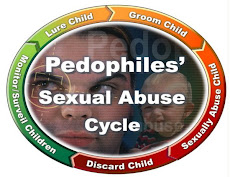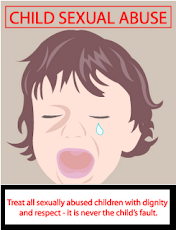Sexual Abuse, Sexual Exploitation, and the Commercial Sexual Exploitation of Children in Indonesia
.
.
.
.
.
Provided by
DR WIDODO JUDARWANTO
DR WIDODO JUDARWANTO
FIGHT CHILD SEXUAL ABUSE AND PEDOPHILIA
Yudhasmara Foundation
JL TAMAN BENDUNGAN ASAHAN 5 JAKARTA PUSAT, JAKARTA INDONESIA 10210
PHONE : (021) 70081995 – 5703646
email : judarwanto@gmail.com,
http://pedophiliasexabuse.blogspot.com/
Yudhasmara Foundation
JL TAMAN BENDUNGAN ASAHAN 5 JAKARTA PUSAT, JAKARTA INDONESIA 10210
PHONE : (021) 70081995 – 5703646
email : judarwanto@gmail.com,
http://pedophiliasexabuse.blogspot.com/
.
.
.
sourcde : www.org.com, Published in the Child Workers of the Asia
This is an extract of a report prepared for Indonesia, which commissioned a study on the situation of the children in especially difficult circumstances covering the issue of child labour, street children and sexually exploited children. The Indonesian version of this report was published soon. Mohamman farid, the author of this report has given his consent to this extracted version.
Child Prostitution
Child prostitution in Indonesia is increasing and seems to be widespread. In Java, for example, child prostitution is reported to cover the whole of island from east to west, from the metropolitan areas to the peripheral towns. In Greater Jakarta, child prostitution is evident in some public parks, the streets, plazas, cafes, and discotheques, as in certain brothels within the authorised red light district and in some hotels. The involvement of girls of elementary or junior high school age in covert prostitution is also identified
The extent of child prostitution in Indonesia if often underestimated, because of a number of factors. Firstly there is confusion with the definitions of a 'child' and prostitution'. In Indonesia, a married person of whatever age is considered - legally and culturally - to be no longer a child. This has rsulted in much confusion as authorities, parents and society in general do not consider the prostitution of wives or windows aged below 18 in anyway a manifestation of child prostitution.
Aside from the official stance that renders prostitution outside authorised complexes illegal, the prevailing presumption among the general society, which considers prostitution as immoral and thus to be kept out of the public agenda, has pushed the issue further out of sight. Given the social stigma, children are generally anxious about their involvement being discovered, particularly by people close to them. They operate clandestinely in small groups, using secret codes, which are changed immediately when publicly disclosed. As was reported recently, of 100 young females interviewed, aged 12-19 years who were involved in such a covert prostitution, 82 claimed that their parents would not find out. They screen potential clients, prefer to be picked upin cars to avoid being suspected by their families and neighbors. Electronic communication devices such as cellular phones and engage in. Thus, there are reasons to suspect that the actual prevelance of children involved in the underground prostitution may be higher that any observer sensed.
Bearing these factors in mind and having examined every piece of available information, an initial moderate estimate of the prevalence of child prostitution in Indonesia is that around 30 percent of the total sex workers in the country are aged under 18 years. This constitutes around 40,000 to over 150,000 based on different estimates of the number of sex workers.
Trafficking of Children for Sexual Purposes & Child Pornography.
Reports indicate that the routes for trafficking children, either domestic or international trafficking, appear to be the same as those transporting adult women. The only case where the routes may have been developed exclusively for child sexual trafficking are those from Bali to some unidentified international destination(s) involving an American, an Australian, and a French citizen.
Another form of child sexual trafficking is taking place through matching agents. This seems to be particular to West Kalimantan where Indonesian females including those aged under 18 are offered the opportunity to marry Taiwanese or Hong Kong-Chinese. Around 40 females are sent to Taiwan and Hong Kong monthly. Some of them arrive to a happy family life, but others are reported to have faced forced marriages or were drawn into prostitution.
Child pornography probably occurs on a lesser scale than other forms of commercial sexual exploitation of children (CSEC). To date, only one case has been uncovered and reported in the media, involving boys who were sexually molested on Lombok. However, as revealed by local resource persons, at least in Surabaya and Ujung Pandang the use of sex workers including under-aged ones for visual pornography is not unusual. Additionally, a prostituted child during an interview (case study) claimed that besides knowing that some of her friends were used in the production of such pornography, she herself was often urged by some local journalists to be photographed in this way. She also claimed that one customer made a video recording of himself and her engaged in sexual activity. Finally, three local homepages with international web links have been identified as exclusive servers of pornography, in which figures suspected to be teenagers are involved (website surfing).
Whilst the underlying factor is undoubtedly poverty, the direct factors pushing them into prostitution are attributed to early sexual experience including sex abuse, early marriage, being lured by friends or relatives already involved in prostitution, or being enticed by agents. Some others are probably motivated more by a consumerist life style.
Besides their vulnerability to drug abuses, sex workers are at most risk of contracting STDs including HIV/AIDS. It normally takes 6-12 months before they acquire adequate knowledge of such risks and become accustomed to using contraceptive preventive aids. They usually learn about certain medicines to treat VD, initially from their senior counterparts. Only after having contracted infections do they then become more cautious of these diseases. Likewise, the segment to which the sex workers belong determines the probable incidence of STDs. The higher the class, the lower the likelihood of getting infected, as they have more access to medical services.
Gender Dimensions
The victims of child sexual abuse and CSEC are predominantly female. With child sexual abuse, 13 mass media agencies indicated that the number of boy victims increased between 1994 and 1996. However, of the total cases recorded during those years, the proportion of girl victims was as high as 93.5 per cent. In the case of CSEC, there are obviously more girls than boys involved in child prostitution, whilst not a single report on sexual trafficking of boys was found despite a relatively large number of reports concerning the trafficking of girls. Male children however, are reportedly found among the victims of child pornography.
Socio-cultural Factors
Certain cultural beliefs have been identified as causing child sexual abuse. These include the belief that magical power is gained - through either heterosexual or homosexual intercourse with children. Such beliefs have even become institutionalised within certain social settings, and thus child sexual exploitation is socio-culturally legitimised and reinforced. The practice of nggemblak by warok, in the district of Ponorogo in East Java, provides a good example. It is believed that having boy concubines (called gemblak) is necessary to sustain and increase the magical power of warok, and having more gemblak gives a warok higher social status. As it shows that he can afford to take care of the economic necessities of more boys and their families as well. Likewise, the belief that having sexual intercourse with children is rejuvenating obviously gives a pretext to the demand for both non-commercial and CSEC.
Child Labourers and their Risks
Whilst street children are obviously vulnerable to both sexual abuse and CSEC, child labourers are also at high risk of such abuses. In this regard, it is worth remembering the cases of under-ageci migrant workers whose ages are falsified. Femalemigrant workers are highly vulnerable to the risk of becoming victims of sex abuse; the children smuggled as migrant workers must be equally at risk. Similarly, girls whose mothers are away as migrant workers and may thus be neglected may also be at risk of sex abuse.
Lack of Educational, Vocational & Employment Opportunities
An inability to afford schooling pushes children into further risk of sex abuse, since they are more likely to be exposed to harmful envirom-nents. Schools, at least, provide a somewhat safer envirom-nent for children. A lack of education also means less opportunity to gain vocational skills, fewer job opportunities, forcing some children into commercial sex as a means of earning money.
Poverty, Rural-urban Migration and Consumerism
Poverty can result in the sale of children by their own parents for commercial sexual purposes. The saie of children, which is related to rural-urban migration, was found (investigative interview). Children of poor families, by nature of their poverty, are in general less likely to be protected and thus face a higher risk of commercial sexual exploitation. In other words, poverty creates the necessary conditions for pushing children to become victim of C SEC. Aside from poverty, consumerist life style has also been documented as enticing children, particularly those living in metropolitan areas, to become involved in prostitution prematurely.
Sexual Abuse
A WHO study found that 61 per cent of street walkers had been abused sexually during their childhood. Likewise, of the 13 prostituted girls interviewed, seven admitted having been sexually abused at the age of 11 - 1 5 years. Clearly indicating that child sex abuse results in the abused child becoming involved in child prostitution. Moreover, having been involved in prostitution, the girls are put at risk of becoming victims of child sexual trafficking or pornography. Althouch the linear pattern may not always be the case, the indications suggest that generally those sexually abused end up in CSEC.
Premature Sexual Experience, Arranged or Early Marriage
Premature sexual experience is also likely to put girls at risk of CSEC, as all but one of the prostituted girls interviewed in Medan, Semarang, Surabaya and Manado admitted to having had such experience, including sexual abuse, prior to getting lured into prostitution.
The practice of early marriage is certainly another important factor contributing to CSEC. In Java marriages can be arranged when the girls are at a very young age. In the district of Indramayu, there are at least six kinds of cheap and easy wedding ceremonies, which in the local context are equally legitimate. Early marriage generally carries a high risk of separation, and young women separated from their husbands lose the social and economic legitimacy to go back and live under the custody of their parents. Given their minimum education amidst the lack of alternative job opportunities, prostitution may become their only alternative.
Demand from Tourism Industry and Paedophiles
It is predicted that Indonesia will become an alternative target for child sex tourists and international paedophiles rings. There are at least three reasons to support this prediction. First, the widespread prevalence of HIV/AIDS in former child sex destinations such as Thailand and the Philippines has made child sex tourists look for safer destinations. Second, increased awareness among NGOs and other sections of the civil society in those countries have successfully pressured their governments to take a tougher stand against CSEC, particularly against child sex tourists. Third - as promotion of tourism in Indonesia is on going, and is targeted to become a significant foreign exchange earner for Indonesia - the climate is likely to welcome any tourist, including child sex exploiters.
Today's Victim, Future Exploiter
Child victims of sex abuse and victims of CSEC are more likely to become potential exploiters. Children who have been caught up in the web of CSEC as a consequence of physical, emotional or sexual abuse, particularly when they come from substance abusing dysfunctional families are unlikely to have suitable adult models of parenting and caring to draw upon. Under these conditions they will be at great risk of perpetuating the behavioural cycle of physical, emotional or sexual abuse to their offspring. In this way, the pathways into the intergenerational patterns of CSEC and sex abuse are constructed.
.jpg)









.png)

Tidak ada komentar:
Posting Komentar